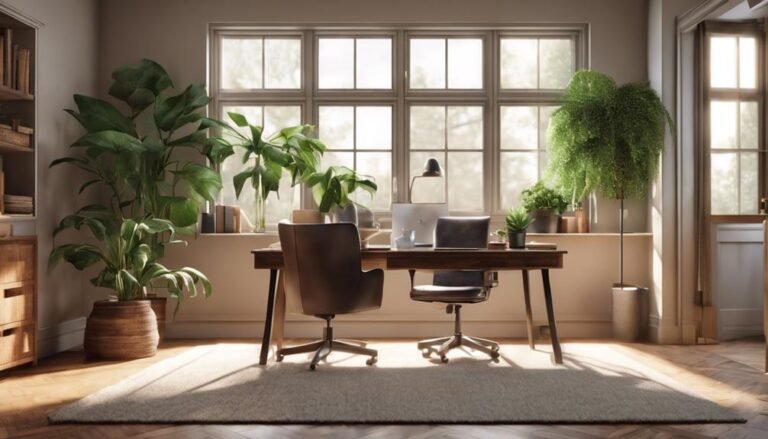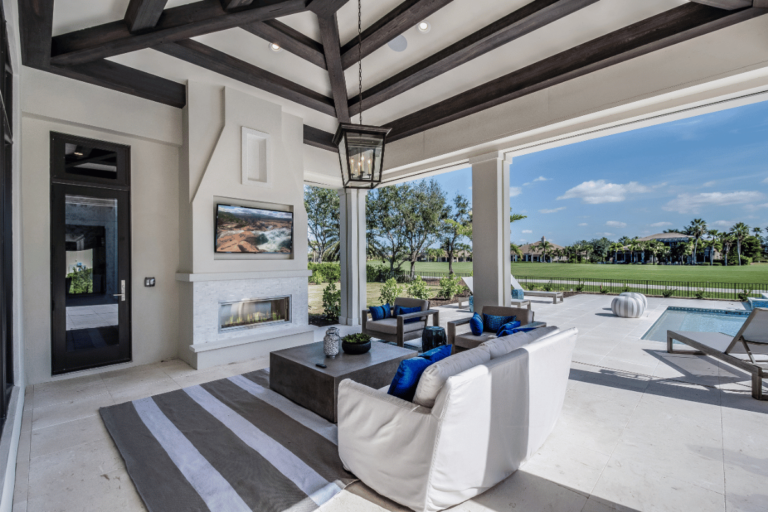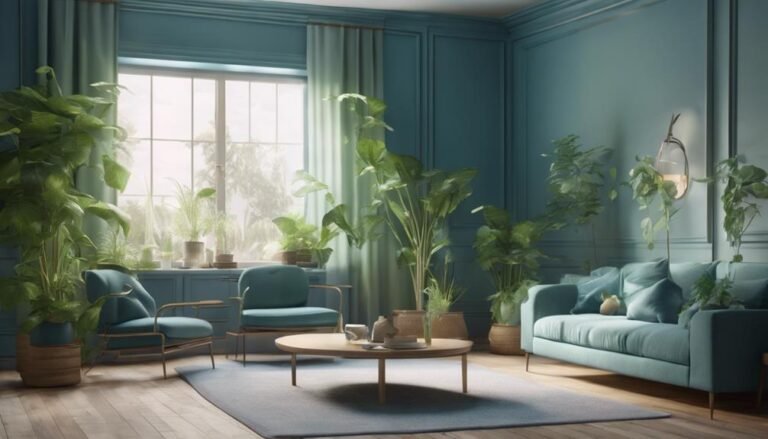Smart Lighting Solutions: How to Use Light to Improve Sleep and Wellbeing
When it comes to optimizing your sleep and overall wellness, the role of light cannot be underestimated. Imagine a world where your environment effortlessly adapts to support your body's natural rhythms, promoting a deeper, more rejuvenating rest. Smart lighting solutions hold the key to accessing this potential, offering a sophisticated yet user-friendly way to harness the power of light for your benefit. By exploring the intricacies of how light impacts your sleep and wellbeing, you may discover a wealth of possibilities to enhance your daily life and vitality.
Key Takeaways
- Customize lighting schedules to align with circadian rhythm.
- Use dimming features to signal relaxation before bedtime.
- Adjust color temperatures for mood regulation and sleep enhancement.
- Experiment with different lighting scenes for varied activities.
- Minimize evening light exposure for better sleep quality.
Understanding Circadian Rhythms
Explore the wonders of your body's internal clock by delving into the fascinating world of circadian rhythms. Your sleep patterns are intricately linked to this natural cycle, which is influenced by external factors like light.
Exposure to natural light during the day helps regulate your body's production of melatonin, the hormone responsible for promoting sleep. Understanding this connection can help you optimize your sleep schedule and overall wellbeing.
Light therapy is a technique that leverages the effects of light on your circadian rhythms to improve sleep patterns. By strategically using light exposure, especially in the morning, you can help synchronize your internal clock and enhance your overall sleep quality. This method is particularly beneficial for individuals who may not have sufficient access to natural light during the day.
Incorporating light therapy into your daily routine can positively impact your melatonin production, making it easier for you to fall asleep at night and wake up feeling refreshed in the morning. By aligning your exposure to light with your body's natural rhythm, you can create a more harmonious relationship with your internal clock.
Benefits of Blue Light Exposure
Harnessing the power of blue light can provide numerous benefits to your daily routine, influencing your well-being in unexpected ways. Blue light exposure has been linked to several advantages, including reducing eye strain and boosting mood through innovative blue light therapy techniques.
When it comes to blue light benefits, it's important to note its impact on eye strain. In today's digital age, we spend a significant amount of time in front of screens, leading to discomfort and fatigue. Blue light can help alleviate this strain by promoting alertness and improving visual acuity, ultimately enhancing your productivity and overall comfort.
Moreover, blue light is also known for its mood enhancement properties. Exposure to blue light can increase serotonin production, the hormone responsible for regulating mood and promoting a sense of well-being. By incorporating blue light into your environment, whether through smart lighting solutions or natural sunlight, you can uplift your spirits and improve your emotional state.
Incorporating blue light into your daily routine can be a game-changer, offering tangible benefits for both your physical and mental well-being.
Reducing Evening Light Exposure
To optimize your well-being, consider limiting your exposure to evening light sources to promote better sleep quality and overall health. One effective way to reduce evening light exposure is by utilizing light-blocking curtains or blinds in your bedroom. These can help prevent unwanted light from street lamps or neighboring buildings from disrupting your sleep patterns.
Additionally, consider minimizing screen time on electronic devices such as smartphones, tablets, and computers at least an hour before bedtime. The blue light emitted from these screens can interfere with your body's natural circadian rhythm, making it harder to fall asleep.
Creating a conducive environment for rest and relaxation involves being mindful of the type of light you're exposed to in the evenings. By incorporating light-blocking solutions and reducing screen time, you can signal to your body that it's time to wind down and prepare for a restful night's sleep.
Prioritizing these adjustments can lead to improved sleep quality and overall well-being.
Creating Relaxing Sleep Environments
You can transform your bedroom into a tranquil oasis by dimming the lights and choosing warm colors. By adjusting the lighting to softer hues, you signal to your body that it's time to wind down and prepare for sleep.
Incorporating these smart lighting solutions can help create a relaxing environment that promotes restful nights and rejuvenated mornings.
Dimming Bedroom Lights
With the touch of a button, immerse yourself in a tranquil atmosphere by dimming your bedroom lights to create a relaxing sleep environment. By utilizing smart bulbs and dimmer switches, you can easily adjust the brightness and color temperature of your lighting to suit your needs.
Dimming your bedroom lights not only helps signal to your body that it's time to wind down and prepare for sleep but also reduces harsh lighting that can strain your eyes and disrupt your natural circadian rhythm.
Installing dimmer switches allows you to customize the level of brightness in your bedroom, giving you the flexibility to create a soothing ambiance that promotes relaxation. Smart bulbs offer additional features such as scheduling dimming routines or adjusting settings remotely through a smartphone app.
This level of control empowers you to tailor your lighting to your unique preferences and optimize your sleep environment for a restful night's sleep. So, take advantage of this innovative technology to transform your bedroom into a peaceful sanctuary that promotes rest and rejuvenation.
Choosing Warm Colors
Enhance your bedroom's ambiance for a restful night's sleep by selecting warm colors that evoke a sense of tranquility and relaxation. Color psychology plays a significant role in creating a calming atmosphere, making it essential to choose hues that promote a sense of peace and serenity.
When it comes to lighting design, opting for warm tones like soft yellows, gentle oranges, and muted reds can help create a cozy and inviting sleep environment.
Mood lighting is vital in setting the right tone for bedtime relaxation. By incorporating warm colors into your lighting scheme, you can signal to your brain that it's time to wind down and prepare for sleep. These colors have a soothing effect, making it easier for you to relax and drift off into a peaceful slumber.
Personalizing Lighting for Wellbeing
Crafting a tailored lighting environment can greatly impact your overall sense of wellbeing and productivity. By customizing settings to match your individual preferences and incorporating lighting schedules into your daily routines, you can create a personalized lighting experience that promotes wellness.
Consider setting up different lighting scenes for various activities such as work, relaxation, or sleep. Bright, cool-toned lights can help you stay alert and focused during the day, while warm, dim lighting in the evening can signal to your body that it's time to unwind and prepare for rest.
Experiment with adjusting the intensity and color temperature of your lights to see what works best for you at different times of the day. For example, you may find that a softer, warmer light in the morning helps ease you into the day more gently.
Pay attention to how different lighting setups affect your mood, energy levels, and sleep quality, and make adjustments accordingly to optimize your wellbeing. With personalized lighting tailored to your needs, you can create a harmonious environment that supports your overall health and happiness.
Smart Lighting Automation Tips
Get ready to elevate your lighting game with some innovative automation tips. Timing isn't just for schedules; it's also crucial for your sleep patterns.
Plus, don't forget about color temperature adjustments to set the perfect ambiance.
Timing for Sleep
Personalizing your smart lighting automation for ideal sleep timing can greatly enhance your overall well-being and restfulness. By aligning your lighting schedule with your natural sleep cycle, you can optimize your bedtime routine for a more restorative rest. Understanding your sleep cycle is vital for setting the right lighting cues at the appropriate times.
As you wind down in the evening, consider programming your smart lights to gradually dim, mimicking the natural decrease in daylight. This gentle shift signals to your body that it's time to start preparing for sleep. Additionally, incorporating warm, dim lighting in the hour leading up to bedtime can help stimulate the production of melatonin, the hormone that regulates sleep.
Creating a calming ambiance through your smart lighting can promote relaxation and signal to your body that it's time to unwind. By syncing your lighting with your sleep cycle and bedtime routine, you can improve your overall sleep quality and wake up feeling more refreshed and rejuvenated.
Color Temperature Adjustment
Adjusting the color temperature of your smart lighting can enhance the ambiance and functionality of your space, creating a personalized and dynamic environment tailored to your needs. By utilizing light therapy principles, you can optimize your sleep patterns and overall wellbeing. Color temperature plays an essential role in influencing our circadian rhythm and mood, making it a key aspect of smart lighting automation.
Incorporating color psychology into your lighting setup allows you to create different atmospheres for various activities. For example, warmer tones like soft yellows and oranges can promote relaxation techniques, ideal for winding down in the evening. On the other hand, cooler tones such as blues and whites can help increase focus and productivity during the day.
Experimenting with different color temperatures throughout the day can mimic natural light changes, aiding your body in regulating its internal clock. By strategically adjusting the color temperature of your smart lighting, you can effectively improve your sleep quality and overall sense of wellbeing.
Conclusion
Illuminate your way to better sleep and wellbeing with smart lighting solutions.
Let the gentle glow of customized light schedules and colors guide you to a restful night's sleep.
Dim the lights and create a soothing atmosphere that syncs with your body's natural rhythms.
Embrace the power of light to rejuvenate your mind and body, and awaken feeling refreshed and ready to conquer the day.
Sleep well, dream big, and shine bright with smart lighting.






